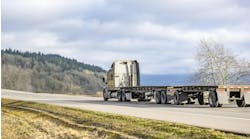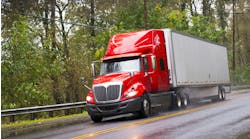Navigating the CARB prebuy for truck procurement: What fleets need to know
The U.S. Environmental Protection Agency (EPA) recently announced it approved California's plans to require an increasing number of zero-emission heavy-duty trucks as the state pushes to cut pollution through its California Air Resources Board (CARB). Gov. Gavin Newsome is expecting that half of all heavy-duty trucks sold in the state will be electric by 2035.
Under the new rules, only zero-emission medium- and heavy-duty trucks would be available for sale in California starting with the 2040 model year. Commercial fleets of 50 or more vehicles, or fleets that generate more than $50 million in gross revenue, any new truck purchased after Jan. 1, 2024, must be zero emissions.
CARB mandates will cause a spike in prebuy activity
However, vehicles with differing types and usages would have various phase-in dates according to the CARB plan. As such, state and local governments would be required to obtain zero-emission vehicles amounting to 50% of the additions to their fleets beginning in 2024. All new purchases would have to be ZEVs beginning in 2027. This means that truck and engine manufacturers have less than three years to undergo what industry observers label as a “manufacturing miracle” to meet the new ultra-low-NOx mandates.
As more fleets become aware of the CARB mandates and plans, the other large unknown is how much of an impact this ruling will have on the truck procurement cycle.
See also: Biden administration OKs California waivers to mandate electric trucks
A report recently released by ACT Research illustrates that a significant prebuy of Class 8 trucks may be likely before the Environmental Protection Agency’s (EPA) upcoming round of emissions regulations targeting diesel exhaust emissions in 2027. ACT analysts believe the new standards will likely result in the largest truck pre-buy ever, beginning sometime in 2025 or 2026. However, the industry may also face a large pre-buy in 2023 ahead of the CARB mandate in 2024.
Why are headlines about prebuys significant? Some industry observers believe these new mandates will further drive up the cost of diesel trucks to the tune of $25,000 - $30,000 extra per unit. Industry insiders also believe this will increase component costs by as much as $5,000.
Additional pressures to constrained supply chains
Pre-buy activity could very well place further strains on fleets working through supply chain delays in the truck procurement process.
Due to these supply chain disruptions, fleets will be challenged to pull a high percentage of their 2024 calendar year purchases into 2023. It is important to note that existing engine platforms will be able to meet 2024 regulations, including diesel particulate filter reconfigurations, fuel management systems, and warranty extensions, to ensure timely repairs are made.
In meeting the 2027 CARB mandate, 2026 is expected to be the largest prebuy. Two thousand twenty-seven mandates will introduce natural gas, electric and hydrogen engine types, and many diesel platforms will have to make significant changes to meet these new CARB requirements.
Fleets taking a reactionary approach will suffer
However, the rush to pre-buy most likely means many fleets will take a reactionary approach to their procurement strategy, creating additional strains on supply chains. Leading fleets are instead working with their asset management partners to identify a holistic approach that leverages data and analytics to build a fleet modernization plan, and this will result in lowering their bottom-line costs over time.
See also: With new trucks scarce, fleets alter course to address tractor needs
Another reason asset management partners are so valuable is that they help to make data more actionable. Fleets today are inundated with data. Most fleets have maintenance software systems that will provide every repair and every line item. They also have ELDs and onboard computers that tell you where you’ve gone, how many miles you’ve run, how heavy you were when you ran those miles, and what part of the country you were in. However, companies need help today taking all that data and saying, ‘What is the offering from the OEM? What is out there in the marketplace? What is the data that we’ve collected telling us? And how do we put that into a roadmap for the next one, three, and five years?’
Actionable data and procurement planning will help
This level of actionable data-driven insight is crucial because it helps fleets build modernization studies, which have been proven to create more flexibility and business agility. These strategies are helping them pay closer attention to their truck’s life cycles to understand where they can save money by optimizing and shortening replacement cycles. Fleet studies take a closer look at performance data and economic factors that help fleets arrive at the right procurement strategy, shortening the life cycle and preventing lengthier truck use. Additional data is being used in emissions scorecards to evaluate and reduce a fleet’s carbon footprint.
The fleets that operate with the lowest cost of ownership are the ones that subscribe to this flexible and environmentally responsible procurement strategy, as opposed to the legacy, pre-pandemic mindsets that were built on gut instincts and a “this is what I know, this is what I trust, this what I’ve seen” philosophy.
Asset management partners can also help fleets as they realistically bridge today’s clean-diesel technology into tomorrow’s alternate fuel options, through an appropriate ESG roadmap to determine truck procurement strategies with optimal life cycle management. This will maximize environmental considerations and organically progress toward alternate fuel technology. In doing so, fleets will achieve critical ESG goals and continuously operate the most appropriate equipment for their operation.
See also: Fleets seek flexibility amid ongoing economic challenges
In reading today’s headlines and recognizing the CARB mandates, fleets understand the importance of transitioning to a greener footprint. Still, the application must be appropriate for each fleet and its operations.
It’s about fitting into a fleet’s life cycle when you have identified the right areas that make sense close to the distribution network. It’s not feasible for someone who’s going 500 miles a day since the charging infrastructure is not ideal on the highways. Therefore, it is important to leverage utilization data to identify what percentage of electric is going to fit into a fleet over the next one, three, and five years.
All of this means that forward-thinking fleets leveraging strategic asset management partners and actionable data will avoid the need to react to prebuy cycles enabling them to focus on their operations and realize a lower total cost of ownership while transitioning to emission-free trucks over time.
Brian Antonellis, CTP, is senior vice president of fleet operations at Fleet Advantage, a provider of truck fleet business analytics, equipment financing, and life-cycle cost management.



